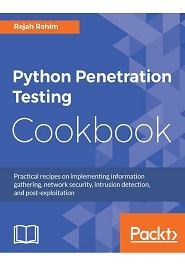
English | 2017 | ISBN: 978-1784399771 | 226 Pages | EPUB | 10 MB
Python Penetration Testing Cookbook: Practical recipes on implementing information gathering, network security, intrusion detection, and post-exploitation
Over 50+ hands-on recipes to help you pen test networks using Python, discover vulnerabilities, and find a recovery path
Penetration testing is the use of tools and code to attack a system in order to assess its vulnerabilities to external threats. Python allows pen testers to create their own tools. Since Python is a highly valued pen-testing language, there are many native libraries and Python bindings available specifically for pen-testing tasks.
Python Penetration Testing Cookbook begins by teaching you how to extract information from web pages. You will learn how to build an intrusion detection system using network sniffing techniques. Next, you will find out how to scan your networks to ensure performance and quality, and how to carry out wireless pen testing on your network to avoid cyber attacks. After that, we’ll discuss the different kinds of network attack. Next, you’ll get to grips with designing your own torrent detection program. We’ll take you through common vulnerability scenarios and then cover buffer overflow exploitation so you can detect insecure coding. Finally, you’ll master PE code injection methods to safeguard your network.
What You Will Learn
- Learn to configure Python in different environment setups.
- Find an IP address from a web page using BeautifulSoup and Scrapy
- Discover different types of packet sniffing script to sniff network packets
- Master layer-2 and TCP/ IP attacks
- Master techniques for exploit development for Windows and Linux
- Incorporate various network- and packet-sniffing techniques using Raw sockets and Scrapy
Resolve the captcha to access the links!